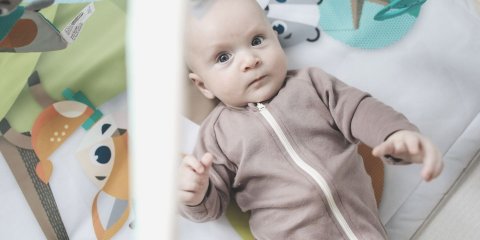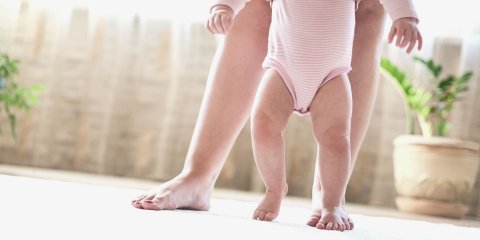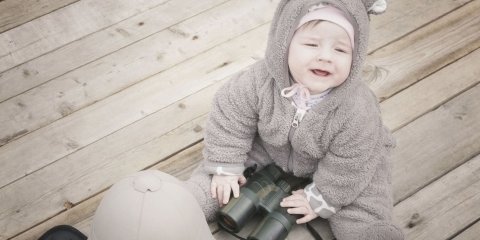Key Points
- Onesies are usually made up to size 2 or 3
- The real answer to “when do babies stop wearing onesies”: it’s a personal choice
- When your baby becomes more active, it can be harder to dress them in onesies
- Potty training can be a little easier if your baby has stopped wearing onesies
Onesies are great for babies : stretchy, comfortable, safe (no chance of them covering the head during sleep) and pretty cute. But, wearing onesies doesn’t last forever.
“When do babies stop wearing onesies” is actually a pretty common question if you take a quick look at internet forums - and everyone’s got an opinion. So, the real answer to this question is: it's a personal choice as to when your baby stops wearing onesies .
There’s no specific time when they have to stop. However, you probably won’t find brands making them in sizes larger than 3 (and often only size 2). So even if you wanted to dress your bub in onesies forever, you can’t.
According to Mummy’s Busy World blog, “on average infants stop using onesies at some point between 12 months (1 year) – 24 months (2 years).”
But, there are so many factors that go into whether parents continue to dress their babies in onesies, even into toddlerhood or only to wear at night time for sleep
Let’s look at some of the pros and cons of onesies, to help you decide when is the right time for your baby to stop wearing them.
But first, to clarify: sometimes people have different ideas of what onesies are. Traditionally, onesies were just bodysuits - essentially a t-shirt that snaps underneath the nappy. But, with the rise of the full-length adult “onesie”, the term has been broadened.
So, for the purpose of this article, onesies encompass bodysuits, singlet suits, full-arm and leg coveralls and rompers, as well as anything else that is a one-piece which snaps or zips up.
When do babies stop wearing onesies?
Let’s talk nappies
Bodysuits, especially, are great for keeping nappies secure thanks to their design which snaps underneath. It can give you peace of mind for preventing or containing leaks when using disposables.
However, it is worth noting that the opposite can be true for cloth nappies. Bodysuits (especially if they are a close fit) can cause compression leaks, by pressing in on the cloth nappy. So if your baby is wearing cloth nappies, you might choose to move away from onesies sooner.
If your baby has started taking off their own nappy (but they aren’t ready for toilet training), onesies are so handy to prevent this. And it’s another win for onesies to stop your little ones sticking their hands down their nappies and, dare I say it, painting the room with their poo.
Let’s talk potty training
The start of potty training usually heralds the change from onesies, to more “regular” clothes like t-shirts and shorts. It’s a matter of convenience.

Toilet training can be stressful for parents. It’s often messy at the beginning, and you can face resistance from your baby or toddler. Even If you have patience in spades, finding ways to make toilet training just a little bit easier should always be encouraged.
Shorts that can be pulled down, along with pull-up style nappies or undies, are much easier than onesies for a few reasons:
- Onesies with snaps located underneath make access more difficult - both for you in the early training period, but also as your child tries to do things for themself.
- Full-length onesies are difficult to get your child in and out of while standing up. And let’s face it, getting them to lie down to undress before sitting on the potty or toilet, just doesn’t make sense.
- Sometimes (ok a lot of the time!) the toilet is needed in a hurry. Pulling down shorts and nappy or undies in one quick motion is the way to go.
Let’s talk convenience
Zippered onesies are super convenient because you don’t have to put them over baby’s head . Just lay them on top and tuck them into it - easy peasy! If you love this about the zip onesies, you might wait until they are sitting or crawling before moving away from onesies.
Zippered onesies are also great if you have a spewy baby because you don’t have to remove any soiled clothing over their head.

Some people stop putting babies in onesies when they start to crawl. Although it offers a little protection for their knees, the fabric gets worn easily and your onesies will soon have very holey knees.
And once bub is on the move, getting snaps lined up correctly becomes a whole new ball game - the frustration when you have to start all over again is real.
What about as they get even older? As babies turn into toddlers they get messy! Some fruit on their shirt? Some mud on their pants?
When they’re wearing “regular” clothes, it’s easy just to whip off the offending item and replace it. And you’ll probably be doing this several times a day! But, when they’re in a full-length onesie, you have to take the whole thing off and start again.
Let’s talk walking
For some parents, when their bubs start walking is the answer to “when do babies stop wearing onesies ”. “According to research literature the mean age for onset of independent walking (AOW) differs between 12 and 14.5 months ”, but of course it can happen earlier and as late as 18 months.
Once your baby is walking , they might be less compliant when it comes to nappy changes and getting dressed. If they are likely to squirm out of your hands and run away when you’re dressing them, onesies (especially the full-length ones) are far from ideal.

It’s going to be much easier to pop a shirt (or dress) over their head and slide some pants on them if they insist on standing while getting dressed.
Additionally, full-length onesies that have feet on them can become a slip hazard for walking babies. And this is just not worth risking! For that reason, you might choose to dress your little one in “regular” clothes during the day, and onesies just for bed .
Once your baby is walking, the easiest way to check if they have dirtied their nappy is to take a quick peek down the back of their pants. If they are in a onesie, you’re left to do the smell test, or get them to lie down and un-snap or unzip them to check (not the easiest thing anymore!).
If they are attending daycare, wearing two-piece clothing means educators aren’t having to do the sniff test when trying to identify a poopy culprit. So, you’re doing them a favour by ditching the onesies!
Let’s talk temperature
In colder temperatures, onesies can be really useful as a layering item , without creating too much bulk in what they wear. They can also help keep your baby’s chest and tummy warm, because they don’t ride up like shirts too when you are carrying them.
Once your little one is crawling around, you might find regular shirts tend to ride up at the back, rather than the front. Just another reason why you may want to continue onesie use in colder seasons.
Let’s talk about those bellies!
From an aesthetic perspective, some people really aren’t a fan of having baby bellies on show, or nappies hanging out when shirts ride up. In those cases, you might prefer to keep the onesies around as long as possible. They keep both of these well contained!
However, if you have a rather tall (or long) baby, you might find onesies just aren’t a great fit for them, or they reach the sizing limit faster. In this case, your best option is to move to longer t-shirts and shorts or pants.
Let’s talk looks
There is so much choice out there when it comes to baby clothes! Parents don’t need to dress their babies in onesies day and night if they enjoy dressing them in cute little outfits - whether that be overalls, jeggings, dress and bloomer sets or sassy slogan shirts.

But, if you’re trying to hold onto babyhood as long as possible, by all means, keep them in onesies until they don’t fit them anymore!
Let’s talk opinionated toddlers
There comes a time when your little one will suddenly expect to have a say in what they wear. If they don’t want to wear a onesie, then your final answer to “when do babies stop wearing onesies” is: when your child says so!
Final thoughts on: when do babies stop wearing onesies?
As you can see, there are a lot of pros for wearing onesies, but also many reasons to stop dressing your baby in them. In many cases, it comes down to lifestyle, your baby’s individual stage of development, and above all, your personal preference.
When do babies stop wearing onesies? It’s completely up to you!

